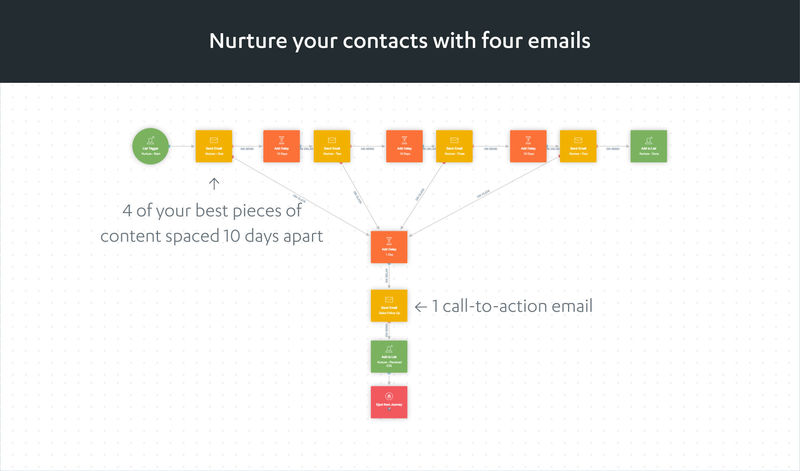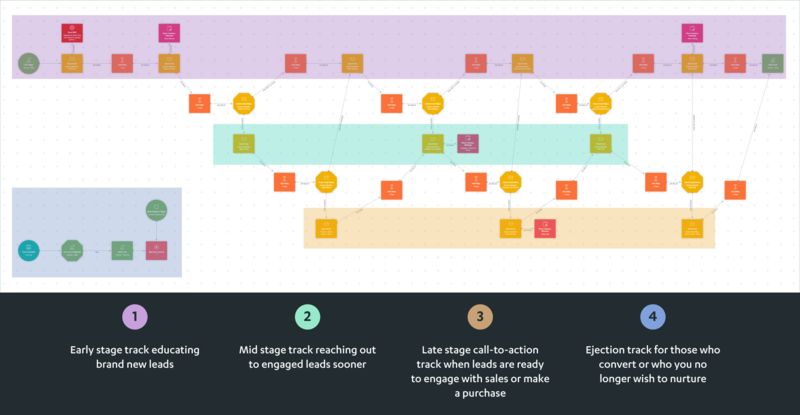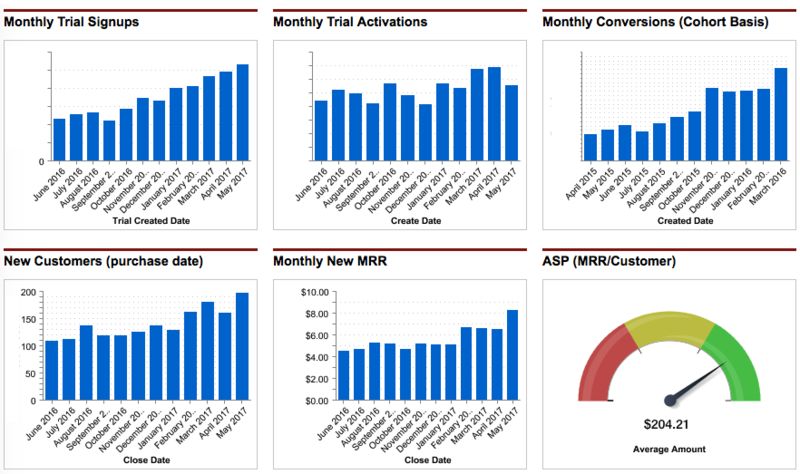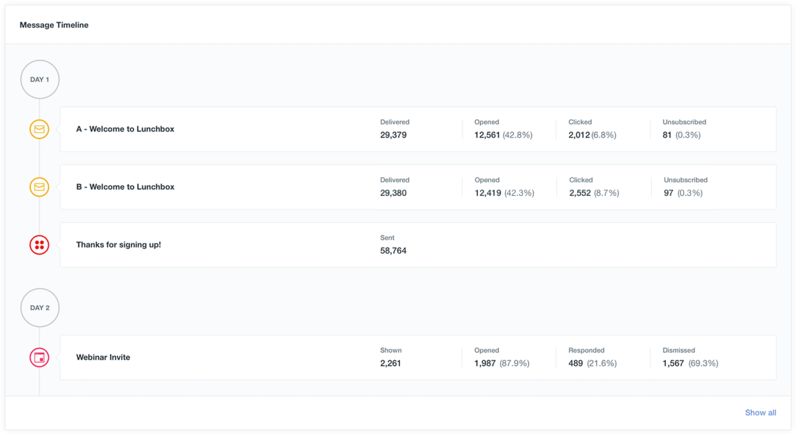Customer Journey Framework to Acquire, Nurture & Grow
auteurs
Les 2: Het Customer Journey Marketing Framework
Wat is de geheime saus voor het bouwen van een schaalbare groeimotor? Het driestappenplan voor customer journey-marketing: Acquire, Nurture, Grow.
We willen allemaal sneller groeien - meer leads, meer aanmeldingen, meer inkomsten. Groei is de brandstof met een hoog octaangehalte waar startups, industrieën en ondernemingen van profiteren. Tegelijkertijd moeten we zo min mogelijk geld uitgeven (aangezien de meesten van ons het Nike-budget of het merkbewustzijn van Google niet hebben).
Wat als we u vertellen dat er een eenvoudige manier is om dit te doen - sneller groeien voor minder geld? (ogen zouden moeten rollen) Dat de beste marketeers een blauwdruk gebruiken om klanten automatisch te werven, koesteren en te laten groeien, terwijl ze ook de ervaring van hun klanten verbeteren en loyale voorstanders winnen?
U staat op het punt te ontdekken hoe de beste bedrijven customer journey-marketing gebruiken om de groei van raketschepen te bereiken en tegelijkertijd op een meer persoonlijke en contextuele manier te werken.
In deze les leer je:
Wat is het Customer Journey Marketing Framework?
Customer Journey Marketing is a proven framework for acquiring, nurturing, and growing customers automatically.
Whereas Inbound Marketing is about “getting found" reactively using content, journey marketing is about proactively driving the customer experience: getting found, converting visitors into leads, qualified leads into customers, and finally customers into repeat buyers and advocates.
Journey marketing uses data to trigger personalized experiences (which in Autopilot are called “journeys") and convert leads into customers at scale. It automates your best practices: your lead funnel, your most impactful and usage-driven product “nudges", effective sales outreach moments, customer onboarding or lifecycle nurturing strategies, event or webinar follow ups, newsletters, and campaigns.
Customer Journey Marketing is a proven framework for acquiring, nurturing, and growing customers automatically.
At the highest level, these are the objectives of journey marketing:
- Acquire more customers by converting visitors into leads and leads into customers
- Nurture leads into paying customers
- Grow your customers
The three phases of the Customer Journey Marketing Framework
The customer journey can be broken down into three distinct phases, each of which has unique goals, triggers, and messaging.
In the Acquisition phase, the objective is to convert anonymous website visitors into paying customers. Here are the stages contacts cycle through during this phase:
Anonymous Visitor → Known Contact → Raw Lead → Qualified Lead → Customer
In the Nurture phase, the objective is to warm up and educate contacts who aren’t ready to buy, then identify those contacts whose actions show buying signals. Here are the stages contacts cycle through during this stage:
Lead doesn’t convert → Add to Nurture → Qualify and Score → Engage
In the Growth phase, the objective is to implement or welcome new paying customers, then maintain a steady drumbeat of automated and batch communications, including online training, events and webinars, usage-triggered nudges, product announcements, newsletters, and upsell or cross-sell journeys, which are designed to grow customer lifetime value (CLV) and earn referrals. Here are the stages contacts cycle through during this stage:
New customer welcomed → Announcements, Enablement, and Events → Long-term buyers
Examples of successful acquire, nurture, and grow Autopilot journeys are provided below.
Why Customer Journey Marketing is important
According to the 2016 State of Customer Journey Marketing report, the fastest growing companies evaluate their performance based on their ability to grow their brand and facilitate high-end customer experiences, rather than purely on customer acquisition.
To do so, 71% of high performers have defined an initiative to map their customer journey and touchpoints. Of those, an astonishing 88% say their customer journey initiative has surfaced opportunities to improve acquisition, satisfaction, and retention.
So, how are these top journey-centric marketers winning?
1. They win on customer experience
Leaders like Amazon and Netflix show that reinvesting gains into creating a personal and contextual customer experience pays for itself many times over. While following in their footsteps may feel like a leap of faith for the “rest of us", consider the situation where your investors or customers ask how product or company growth is coming.
You want to tantalize them with stellar activation rates and rampant word-of-mouth growth. You want customers *raving* online about their experience with your brand.
The last thing you want is lukewarm or muddled feedback that your product has “strong potential, but…"
2. They win by scaling “what works" (best practices)
When you automate your customer journeys, you codify your best sales approaches, messaging, and engagement tactics to grow in a way that’s scalable and profitable.

For example, free trialist to paying customer conversion rates can be increased dramatically by tailoring your messages based on product usage. Similarly, helping inactive users get up and running with your service, while offering power tips and buyer’s guides to active users, is a proven method for both increasing both your conversions and your customers’ satisfaction.
3. They win through retention (the new acquisition)
Marketers are increasingly focusing their sights on customer retention—the “grow" phase of The Customer Journey Marketing Framework.
According to Fred Reichheld of Bain & Company and creator of the Net Promoter Score® (NPS) survey method, increasing customer retention by just 5% boosts overall profit by 25%.
How does customer retention drive growth? Consider how much easier and cheaper it is to increase top-of-funnel acquisition by 20% compared to retaining 20% of your existing customers or reactivating 20% of your hard-earned leads. For many companies, retention-focused marketing is an overlooked yet lucrative source of growth.
How to apply the Customer Journey Marketing Framework
The Customer Journey Marketing Framework consists of five steps:
- 1Map your buyer’s journey
- 2Diagram your “Acquire, Nurture, Grow" system
- 3Assemble your customer journey marketing tool stack
- 4Identify your first must-have journeys
- 5Track results and experiment
Step 1. Map your buyer’s journey
Your buyer’s journey is the chronological set of learnings, touch points, and decisions that a person experiences as they get to know your brand or product. When a lead enters your database, they’re already aware of your company or product. What do they need to learn in order to become qualified and ready for sales?
Taking the time to map this out for each target buyer is almost always an enlightening activity.
Step 2. Diagram your “Acquire, Nurture, Grow" system
You’ve micro-analyzed your customers’ experience of learning and buying from your company. Now it’s time to diagram the internal channels, processes, tools, and customer data sources that must be consolidated to create and automate personalized experiences.
This diagram is the visual blueprint that helps you identify new growth opportunities and evangelize your marketing efforts. Build it, optimize it, and fill it—this is your predictable growth engine throughout the customer journey.
Your diagram should include the following components:
- The marketer’s objective. Structure this into the “acquire", “nurture", and “grow" stages.
- Contact status. You want to convert anonymous into known contacts, contacts into leads, then leads into customers.
- Channels. Identify where anonymous website visitors come from (based on first touch), which typically includes organic, paid, and referral channels
- Systems. What tool(s) are used for each set of journeys? Examples include CRM, automation software, predictive lead scoring, social platforms, etc.
- Directional linkages. How do contacts move from one status to another? For example, from new lead to nurtured lead to reactivated lead.
- Journeys. This indicates automated customer engagement driven by Autopilot, such as trial conversion, contact sales, customer welcome, newsletter, or training journeys.
Diagram a visual blueprint that helps you identify new growth opportunities
In the above example, which is taken from Autopilot, we drive traffic from organic search, referrals, social media, AdWords, Facebook ads, GetApp, and integration partners. Anonymous users are converted to known users using Autopilot-captured forms and Proactive Headsup, in addition to third-party systems like Eventbrite and GotoWebinar.
Raw leads, such as content downloaders, webinar registrants, event attendees, and trial signups, are synced into Salesforce CRM for predictive fit scoring using Infer. Depending on the customer’s database size, leads are routed to distinct “swimming lanes"— either self-service (a velocity sales channel focused on light touches, like group demos and automated sales emails) or a mid-market sales experience.
Once the lead buys, they’re welcomed as a new customer via a usage-tailored onboarding journey, followed by continued education, product announcements, and major communications.
Step 3. Assemble your customer journey tool stack
To build or buy—is that still a question? Today you can design an enterprise-grade marketing stack comprised of easy-to-use tools that play nicely together, sharing data across systems and enabling triggered messaging, rapid execution, and real-time reporting. Plus, most are pretty low cost.
Here’s what a killer customer journey stack enables you to do:
- Ideate, create, and launch new creative journeys in hours (not days or weeks)
- Grow the value of every lead to a high-paying lifelong customer
- Maintain data hygiene to avoid unintended sends or lead duplication
- Personalize messaging at scale
You can design an enterprise-grade marketing stack of easy-to-use tools that play nicely together at a pretty low cost.
Here are a few essential tools that are affordable, easy to use, and work with an Autopilot-centric customer journey marketing stack:
- Conversion rate optimization (CRO): Landing page editors, like Instapage and Unbounce, make it easy to spin up digital campaigns and copy-match from ad click to form complete to Autopilot journey.
- Customer journey automation: Autopilot centralizes and organizes your contact data, personalizes your messages, allows you to nurture customers through the lifecycle, and extracts the insights needed to improve your conversion rates and messaging performance.
- Events and webinars: Sync Eventbrite registrations and attendees into Autopilot and/or capture webinar attendees from GotoWebinar, then trigger event invitation and follow-up journeys.
- Product usage: Incorporate product usage data to increase the relevancy of your emails and journeys, similar to how Facebook’s notification of your friend’s comments on your photo elicits a quick click from you. To do so, use Autopilot’s API or Segment.com to push product events into Autopilot
- Customer relationship management (CRM): If you’re growing sales or customer success, you’ll need a CRM. The first question you should answer is, Salesforce or not Salesforce? The benefits of Salesforce are that it has a flexible data model and robust reporting, works with marketing automation systems and integrates with everything via AppExchange. Popular lighter-weight systems include Pipedrive, Prosperworks, Close.io, Base, Zoho, and Insightly.
- Funnels and visualization: Insights by Autopilot offers simple goal tracking and message performance. For more comprehensive tracking, tools like Heap, Mixpanel, or Amplitude enable multi-goal conversion funnels, cohort performance, and behavior-modeled predictions.
- Predictive lead scoring: Systems like Infer (which Autopilot uses), Everstring, and Leadspaces predict the future likelihood of a new lead converting based on historical purchasing patterns. These tools use machine learning and heavy data enrichment to mine out predictive signals with a high degree of accuracy, and are valuable for improving sales lead quality and identifying poor-performing channels.
- Multi-touch attribution: What most marketers (and leaders) ultimately care about is, which channels, campaigns, and investments pay off? Attribution systems are customized to your funnel, and compute the relative contribution of each touch to revenue generation. This provides a more accurate view of which channels drive ROI based on first touch, last touch, or multi-touch models. For example, Bizible (which Autopilot uses internally) has its own JS pixel to track online touches, and uses Salesforce Campaigns to attribute offline activities, such as trade shows or webinars. Other popular attribution tools include Brightfunnel and FullCircle Insights.
The above list is by no means exhaustive. In fact, it focuses specifically on the customer journey marketing stack. Other essentials include advertising, social media monitoring and engagement, and video, in addition to other marketing channels.
Step 4. Identify quick win journeys
At a minimum, you want a personalized journey for each phase of your customer’s lifecycle. This means converting anonymous visitors into leads, nurturing leads into high-paying customers, leading successful new customer implementations, and regularly staying in touch.
Along the way, flex your creative muscles by personalizing key moments or providing unexpected experiences across multiple channels. Let’s take a look at a few must-have journeys, then get inspired by 10 of our all-time favorites.
Acquire new leads. To generate leads, you first need to drive awareness and earn website traffic! Skip to Course 4 for actionable advice, including how to get up and running with blogging and retargeting.
The Autopilot tracking code allows you to capture the activity of anonymous website visitors and convert them into known leads using gated content and Proactive Headsup – Autopilot’s on-site messaging channel that doubles as a lead generation tool.
Must-have acquisition journeys include:
- Lead follow up: Once a lead submits their contact information, e.g., via a “Contact Us" form, trigger a journey that thanks them for their interest, notifies your internal teams via Slack, and assigns new leads to the right owner or team.
- New User Onboarding: When a user signs up for your product or trial, it’s a moment of excitement for you and them. Affirm they made a good decision by reaching out to welcome them your community and give them an idea of what to expect moving forward. Target your messages based on usage. To shake things up, try reaching out through a new channel like SMS, onsite messages, or even postcards.
For additional resources and in-depth instruction, see the Acquire New Leads course.
Nurture leads into paying customers. Once you’ve acquired and qualified leads, shift your focus to converting them into paying customers. An easy way to do this with Autopilot is to nurture leads until they’re ready to engage. Your goal should be to help buyers overcome common hurdles while teaching them about the space. Read more in our introduction to lead nurturing.
You can help prospective buyers:
- Understand core challenges
- Catch up on industry trends
- Digest product best practices
- Build the business case
- Learn from relevant customer stories
- Plan their purchase and implementation
Effective nurturing requires mapping out your customer’s buying cycle and crafting messages to send at the right time. Advanced tactics to drive performance include messaging across multiple channels (i.e. email, SMS, direct mail) and personalizing content based on product usage or customer data. Learn more about how to personalize your marketing with data.
Here are a two automated journeys to consider in the “nurture" phase:
- A basic four-email sequence: Educate your contacts through a series of interesting content, then accelerate those that show interest through to your sales team. Learn how to build it.

- The nurture machine: For more advanced nurturing, adjust the timing of your communication based on the reader’s stage in the buying cycle. Tailor your messaging to the top, middle, and bottom of the funnel. See the deep dive.

For additional resources and in-depth instruction, see the Nurture Leads course.
Grow your customers. Once you’ve converted your leads into paying customers, they enter the “grow" stage of the Customer Journey Marketing Framework. At this point, your focus shifts to growing with that customer: Help them implement your product or service, nudge them to achieve success milestones, provide updates about new product features, or use a survey to get their feedback.
Flex your creative muscles by personalizing key moments or providing unexpected experiences across multiple channels.
Here are a few automated journeys to consider in the “grow" phase:
- New customer implementation: The most successful customers are those who leverage your product and/or service immediately. An automated onboarding journey that helps them get started is an excellent way to start them off on the right foot.
- Newsletters and major communications: Sending newsletters, company announcements, and event invitations is a great way to maintain a regular drumbeat and build better relationships with customers.
- Reactivate former buyers: Give actionable best practices or invite former users back in, like the below Dropbox email.
For example, Instapage uses Headsup to invite new users to a group demo of its SaaS service. Since launching this in-app message, the company has seen a 30% increase in attendance rate for its weekly demo, leading to increased product usage.
With all of the “grow" journeys, aim to add value and keep your customers excited and invested in your brand. Their loyalty translates into repeat purchases and word-of-mouth growth.
For additional resources and in-depth instruction, see the Grow Customers For Life course.
Step 5. Track results and experiment
Journey marketing is not a set-it-and-forget-it exercise. It’s an opportunity to constantly experiment and improve your performance.
Doing so requires logging your tests and measuring the right business, revenue, marketing, and journey metrics for your company.
Business KPIs
Track your most critical KPIs on a weekly or monthly basis. These may include leads or signups, conversions to wins, total customers, new customers, cancellations, activation rates, and conversion rates. Users of Autopilot and Salesforce can create dashboards in Salesforce to automatically tabulate this data, which can then be entered into a spreadsheet. Or, you can sync your data directly into a business intelligence (BI) tool like GoodData, Domo, Looker, or Periscope.
Lead and attribution dashboards in Salesforce
Because Autopilot integrates natively with Salesforce, you can automatically track leads, contact statuses, usage data, and any other data that you push into either Autopilot or Salesforce. Create dashboards that track revenue, cohorts, activation rates, trends, and averages, and receive daily updates.

You can also implement attribution software (like Bizible) to gain an executive view of your program performance using multi-touch models.
Your conversion funnel
Use Mixpanel, Heap, or Kissmetrics to track your trial signups, activations, and conversions. Develop an activation-to-conversion funnel comprised of one to three specific events to see where users drop out and where your event-based opportunities lie.
Journeys and marketing results
Use Insights, which is built into Autopilot, to track how many contacts convert against your designated goal. Drill into your journey results on a daily basis to see how emails, Headsup messages, SMS, and A/B tests perform.

Wrapping up the Customer Journey Marketing Framework
The Customer Journey Marketing Framework is about acquiring, nurturing, and growing customers. It’s not a silver bullet, but is a proven way to accelerate your growth in a healthy and sustainable way by focusing on the customer experience.
Multiply the value of every lead and guard against leads slipping through the cracks. Then nurture and reactivate your database until they either convert into a paid customer or drop out of your funnel. Finally, focus your journey marketing on growing the relationship via regular communications and education, which will earn your customers’ loyalty and repeat business.
The beautiful part? Very quickly, your machine – the whole thing – will run… on Autopilot.
Best-in-class case studies to reference
Many Autopilot customers have created best-in-class journeys for each stage of the The Customer Journey Marketing Framework. Here are a few of our favorites:
- Learn how LiveChat increased email engagement by 360% through lead generation, sales follow-up, and onboarding journeys
- Find out how Instapage generated $30,000 in reactivation revenue within 2 months of launching a personalized lead nurturing journey
- See how RangeMe accelerated user acquisition growth 18x in 10 months
- Read about Golden Gate Wine’s success in increasing online sales by 150%
Next Lesson
Lesson 3: 10 Inspiring Customer Journeys
You’ve got your framework down. Now let’s get into the fun stuff—what creative marketing journeys will grow your business faster? While there are many avenues to growth, we’ll focus on 10 ...
Go to next lesson Source: flightschool.autopilothq.com


















